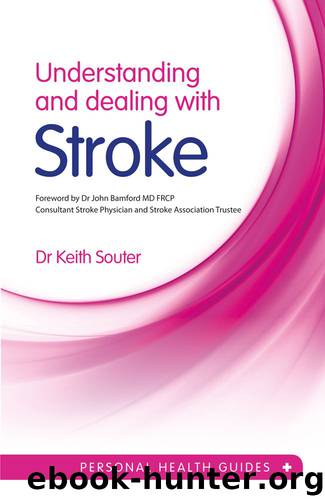Understanding and dealing with Stroke by Keith Souter

Author:Keith Souter
Language: eng
Format: epub
Publisher: Summersdale Publishers
Published: 2012-06-20T00:00:00+00:00
PART 2
DEALING WITH STROKE
An important note about brain plasticity
Before we start looking at recovery and rehabilitation after a stroke, let us consider the important topic of brain plasticity or neuroplasticity.
In a stroke, if brain cells are deprived of blood and oxygen for a critical few minutes, they will die. They will not regenerate. This does not mean that all is lost, because the brain does have the capability of regaining knowledge of or relearning how to do tasks that were dependent upon the part of the brain that has been lost. This capacity is referred to as brain plasticity or neuroplasticity – the ability for the brain to be ‘remoulded’ into learning new processes, achieved with the help of rehabilitative therapy. Essentially, the work carried out by the patient and the various therapists involved in rehabilitation does somehow stimulate the brain to find new and alternate pathways.
The message is that, even if disabilities are severe and are taking a long time to improve, the brain will be trying its best to find these alternate brain cells and nerve pathways. It will be trying to ‘defrag’, to use a computer term, and sort out a means of re-routing information and impulses. So, even if a disability seems to be permanent, it may still be possible for the brain to relearn how to do things. The truth is that we still don’t understand very much about the way that the brain functions and organises things. Rehabilitation after a stroke is an ongoing process which aims to help exploit the plasticity of the brain to achieve the best outcome.
Mirror-box therapy
There have been several studies which show that the rehabilitation of stroke patients can be improved when physical treatments are combined with mental exercises. It seems that this combination works because of brain plasticity.
The use of a mirror box is something that I would personally recommend. Essentially, it involves using a mirror to create an illusion, tricking the brain into thinking that it is moving a paralysed hand or leg, and so can stimulate improvement. It seems to help the brain to find the alternate route to transmit signals.
Effectively, the patient places the affected limb inside a mirror box and looks at their other limb in the mirror. When they move the normal limb and try to move the paralysed one at the same time, the reflection will give the illusion that they are moving the paralysed limb. The movement may be quite simple, like closing and opening a fist.
This sort of exercise can help. The main thing is to keep practising and keep working with your therapist to achieve results.
Download
This site does not store any files on its server. We only index and link to content provided by other sites. Please contact the content providers to delete copyright contents if any and email us, we'll remove relevant links or contents immediately.
Men In Love by Nancy Friday(4974)
Everything Happens for a Reason by Kate Bowler(4486)
The Immortal Life of Henrietta Lacks by Rebecca Skloot(4270)
Why We Sleep by Matthew Walker(4202)
The Sports Rules Book by Human Kinetics(4087)
Not a Diet Book by James Smith(3161)
The Emperor of All Maladies: A Biography of Cancer by Siddhartha Mukherjee(2941)
Sapiens and Homo Deus by Yuval Noah Harari(2858)
Day by Elie Wiesel(2602)
Angels in America by Tony Kushner(2397)
Endless Forms Most Beautiful by Sean B. Carroll(2357)
A Burst of Light by Audre Lorde(2355)
Hashimoto's Protocol by Izabella Wentz PharmD(2209)
Dirty Genes by Ben Lynch(2169)
Reservoir 13 by Jon McGregor(2152)
And the Band Played On by Randy Shilts(2023)
Wonder by R J Palacio(1998)
The Immune System Recovery Plan by Susan Blum(1974)
Stretching to Stay Young by Jessica Matthews(1951)
